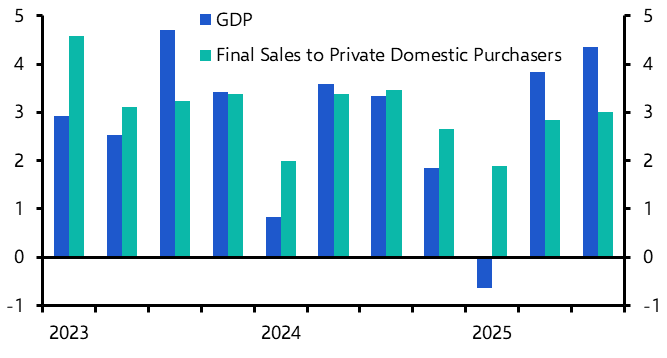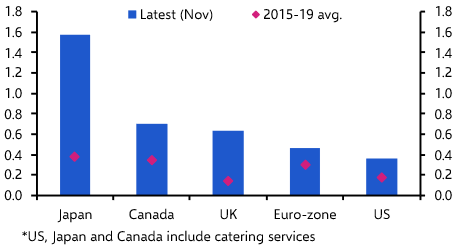Just a few weeks ago, central bankers were grappling with the considerable challenge of maintaining post-pandemic recoveries in the face of a generational surge in inflation. Now, against the backdrop of geopolitical crisis, that policy challenge has become only more acute.
The response of central banks to the surge in global commodity prices – and the war in Ukraine more generally – will come into sharp focus this week, with decisions from policy meetings due in the US (Wednesday), UK (Thursday) and Japan (Friday).
It’s important to stress that recent events are likely to have different consequences for policy outcomes in advanced economies and emerging markets. It therefore makes sense to develop separate frameworks for thinking (you can find our latest analysis and two-year forecasts for major advanced and emerging economy monetary authorities at our Central Bank Hub).
In advanced economies, much of the focus has been on the inflationary consequences of the surge in global energy prices. This poses two challenges for central banks. First, there’s not much that monetary policy can do to influence energy prices since they are set in global markets. Second, while a rise in energy prices increases inflation in the short term, all other things being equal, the subsequent squeeze on real incomes is disinflationary over the medium term.
Accordingly, central banks in advanced economies tend to look through changes in inflation caused by fluctuations in energy prices. The Fed raised interest rates during the 1979 oil shock but cut them when oil spiked during the Iraq War in 1990, and it left them unchanged during the 2011 Arab Spring. None of these shocks prompted a significant change in policy direction. (See Chart 1.)
Chart 1: Federal Funds Rate (%)

Sources: Refinitiv, Capital Economics
There are three issues that central banks must consider when formulating the response to the current commodity price shock. The first is the extent to which higher energy prices, and the effects of the war more generally, will squeeze real incomes and GDP. This will depend in part on the fiscal response to higher energy prices, and whether governments cushion some of the pass-through to households. While the situation is still evolving, the euro-zone economy is likely to experience a larger hit than the US (with the UK sitting somewhere in between).
The second issue is the extent to which the market dislocation caused by the war has caused financial conditions to tighten anyway, thus mitigating the need for further monetary tightening. Our proprietary indicators (which can be downloaded here) show that conditions have tightened significantly across all advanced economies, but particularly in the euro-zone and UK. (See Chart 2.) As we noted last week, although direct financial exposures to Russia are limited, it will be a while before indirect exposures become fully known. In the meantime, counter-party confidence is taking a hit.
Chart 2: CE Financial Conditions Indices (Z-scores)

Sources: Refinitiv, Capital Economics
The final issue to consider is whether the surge in energy prices will have a broader and longer-lasting effect on wage and price-setting behaviour. In this regard, the overriding concern of central banks is that higher energy prices will push up inflation expectations, causing workers to bargain for higher wages and setting in train a self-perpetuating wage-price spiral. But for this to materialise inflation expectations must ratchet up and labour markets need to be tight in order for expectations to feed into higher wages. This is a bigger threat in the US and UK (where labour markets are relatively tight) than it is in the euro-zone.
As things stand, we don’t think that the jump in inflation will be sufficient to push central banks to tighten more aggressively. At the same time, however, the high starting point for inflation – and concerns that it will become embedded in expectations – means that central banks cannot sit on the sidelines altogether. Accordingly, the most likely outcome is that most major advanced economy central banks proceed with a gradual tightening of monetary policy. This was the key message from last week’s ECB meeting. While the decision to accelerate the taper of asset purchases grabbed the headlines, this was counterbalanced by more open-ended guidance on interest rates which passed under the radar.
In emerging economies, inflation expectations are less firmly anchored, and policymakers tend to respond more aggressively to try to quell inflation risks. As a result, EM central banks are more likely to accelerate tightening in response to the jump in inflation. This is particularly true in Latin America and Central Europe, where inflation was already running far above target before the war broke out. Central banks in Poland and Hungary have already tightened monetary policy since the war broke out. Low inflation gives policymakers in Asia more room to keep policy loose, but the risks are tilting towards earlier tightening in parts of the region.
This week, however, market attention will be on central bankers in advanced economies. Only a few weeks ago, there was healthy debate in the market as to whether the Federal Reserve would begin its tightening cycle with a 50-basis point move, or even with a surprise, inter-meeting hike. There’s no question that war in Ukraine has shifted the terms of that debate – but they haven’t shifted too far: in advanced economies, we still think that policy for the most part is likely to be tightened this year, and we don’t think that the peak in interest rates in this cycle is likely to change much.
Note: We’ll be discussing the Bank of England’s March decision in a Thursday briefing online, and how the Bank of Japan will respond to 2% inflation in an online session on Friday.
In case you missed it:
- Our Chief Markets Economist, John Higgins, looks at the lessons for asset markets from previous oil embargos.
- Our Senior China Economist, Julian Evans-Pritchard, unpacks the key messages from the National People’s Congress – and argues that China’s leadership is expecting much weaker growth this year than the relatively upbeat GDP growth target might suggest.



